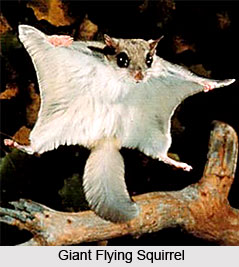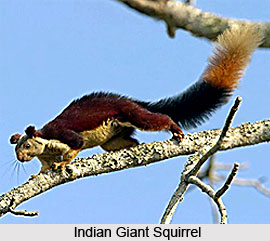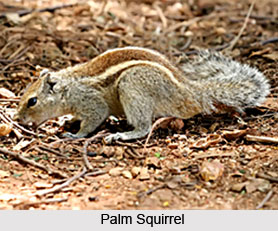 Squirrels belong to the family Sciuridae, a well-defined group within the order Rodentia. Over fifty genera have been included in this family. All the family are characterised by grinding teeth which are low-crowned and cuspidate, and by a peculiar attachment of the masseter (main chewing) muscle which is inserted in the skull ahead of the zygomatic arch. Besides the familiar tree-dwelling and busty-tailed squirrels, it is not generally realized that Marmots, Ground Hogs and the Ground Squirrels of the great natural prairie regions also belong to this family. Prairie Dogs and Susliks are Sciurids and are burrowing short-tailed rodents quite dissimilar in habits from tree squirrels. Twenty of the Indian species are, however, largely arboreal, and are exceedingly active, feeding on buds, fruits, nuts and other vegetable substances.
Squirrels belong to the family Sciuridae, a well-defined group within the order Rodentia. Over fifty genera have been included in this family. All the family are characterised by grinding teeth which are low-crowned and cuspidate, and by a peculiar attachment of the masseter (main chewing) muscle which is inserted in the skull ahead of the zygomatic arch. Besides the familiar tree-dwelling and busty-tailed squirrels, it is not generally realized that Marmots, Ground Hogs and the Ground Squirrels of the great natural prairie regions also belong to this family. Prairie Dogs and Susliks are Sciurids and are burrowing short-tailed rodents quite dissimilar in habits from tree squirrels. Twenty of the Indian species are, however, largely arboreal, and are exceedingly active, feeding on buds, fruits, nuts and other vegetable substances.
Squirrels have lived in captivity for over ten years and have a potential longevity of fifteen to twenty years. The females reach maturity between six to eight months. Mating is promiscuous and the female when in season often mates with several males. Their love life lasts for a day. The gestation period varies from as short as twenty eight days in Ratufa, up to forty two days in Funambulus. During lactation the female spurns all attention from the male and often aggressively drives him away. She makes a nest in which the naked and helpless young are born and jealously guards and rears her offsprings, unaided by the male. Palm Squirrels average three litters a year with an average of three young per litter, and Flying Squirrels in northern latitudes produce only one or two litters per year. Squirrels make large untidy nests of leaves, twigs and vegetable fibre in trees for rearing their young. The nest, known as a drey, is usually placed among the slender, upper branches hidden among the foliage of a tree or in the hollow of the tree-trunk. It may also be used for sleeping during the non-breeding season.
 Not surprisingly because of the advantages offered by tall-tree evergreen forest, eleven out of the twenty tree squirrel species occur in Eastern India, in Assam and in the north-eastern Himalaya. One species of Flying Squirrel, one species of Giant Squirrel and two species of Palm or Striped Squirrels are widespread in the peninsula.
Not surprisingly because of the advantages offered by tall-tree evergreen forest, eleven out of the twenty tree squirrel species occur in Eastern India, in Assam and in the north-eastern Himalaya. One species of Flying Squirrel, one species of Giant Squirrel and two species of Palm or Striped Squirrels are widespread in the peninsula.
Flying Squirrels are distinguished from other squirrels by the presence of an elastic membrane of skin between front and hind legs which act as a parachute and permit the animal to glide from tree to tree, often over considerable distances on hill slopes. The method of `flying` is to jump from a tree at a height to another at some distance and below. At the end of the glide the squirrel banks steeply and lands with all four feet on the tree-trunk. All Flying Squirrels are nocturnal and spend the day in tree hollows. Their presence in a forested area is often known only by their mewing call, which is distinctive.
The Common Giant Flying Squirrel (Petaurista philippensis) is found in forested areas throughout the peninsula. In the Himalaya Mountains three more species of Giant Squirrels and three smaller flying squirrels occur. Some of them, like Hodgson`s Flying Squirrel (Petaurista magnificus), are splendidly coloured, with a bright yellow line down the middle of their back. The Wooly Flying Squirrel (Eupetaurus cinereus) of Kashmir is peculiar in that it only occurs in cold dry areas where tree growth is limited and where it is said to be capable of gliding from rock to rock. It is now an uncommon and rare species known only from a few localities. The Small Travancore Flying Squirrel is peculiar to the forests of Kerala, and is a rare and little-known species.
 Giant Squirrels of the genus Ratufa are the known tree Squirrels in the world, and exhibit a simple polymorphism in coat colour and pattern. Races of the Indian Giant Squirrel (Ratufa indica) are not uncommon in the forests of the peninsula. They vary in colour from the pale cream race (R.i.dealbata) of the Dangs in Gujarat through the Rufous Squirrels to the almost Black Squirrels of Kerala. A widespread race is the Central Indian Gian Squirrel (R.i.centralis) of Madhya Pradesh, South Bihar, Orissa and Eastern Ghats. Giant Squirrels make their presence known by their loud alarm-calls. They are partial to particular patches of forest and build large dreys for breeding and for roosting at night. The Grizzled Giant Squirrel (R.macroura dandolena) is rare and restricted to a small area of deciduous forest on the eastern slopes of the Western Ghats in Tamil Nadu. Other races of this species occur in Sri Lanka. The Malayan Giant Squirrel (R.bicolor) replaces the Indian Giant Squirrel in the Eastern Himalaya and the states of eastern India.
Giant Squirrels of the genus Ratufa are the known tree Squirrels in the world, and exhibit a simple polymorphism in coat colour and pattern. Races of the Indian Giant Squirrel (Ratufa indica) are not uncommon in the forests of the peninsula. They vary in colour from the pale cream race (R.i.dealbata) of the Dangs in Gujarat through the Rufous Squirrels to the almost Black Squirrels of Kerala. A widespread race is the Central Indian Gian Squirrel (R.i.centralis) of Madhya Pradesh, South Bihar, Orissa and Eastern Ghats. Giant Squirrels make their presence known by their loud alarm-calls. They are partial to particular patches of forest and build large dreys for breeding and for roosting at night. The Grizzled Giant Squirrel (R.macroura dandolena) is rare and restricted to a small area of deciduous forest on the eastern slopes of the Western Ghats in Tamil Nadu. Other races of this species occur in Sri Lanka. The Malayan Giant Squirrel (R.bicolor) replaces the Indian Giant Squirrel in the Eastern Himalaya and the states of eastern India.
Striped or Palm Squirrels comprise of five species. The Five-striped (Funambulus pennanti) in the north and Three-striped (Funambulus palmarum) in the south, are both commensal with man in the peninsula. Thriving in all but the most densely populated areas of Indian cities, the Palm Squirrels are the commonest and best-known of Indian squirrels. They are most often seen hanging head down from a tree-trunk, and scolding shrilly at whatever has, at that moment, frightened them. They live largely on the vegetable food found in human vicinity, and occasionally raid birds` nests for eggs. Two to three young are reared at a time, in a nest of vegetable fibre built on trees or in the eaves of houses.
In the jungles of the southern peninsula three more species of Striped Squirrels occur: Layard`s Striped Squirrel (Funambulus layardi), and the Dusky Striped Squirrel (F.sublineatus), both of which live in the forests of Kerala, and the Jungle Striped Squirrel (F.sublineatus) occurring throughout the Western Ghat forests. In the eastern Himalayas the Himalayan Striped Squirrel (Callosciurus macclellandi) replaces the Palm Squirrels. The eastern Himalayas are also the home of several very loud-voiced species of medium-sized squirrels like the Orange-bellied Himalayan Squirrel (Dremomys lokriah), the Red-cheeked Squirrel (Dremomys rufigenis) with its sharply pointed nose, and Perny`s Squirrel (D.pernyi). Two species of Callosciurus, a genus which is well represented by species in Burma, also occurs in eastern India. Very little is known of the squirrels of Eastern India.











